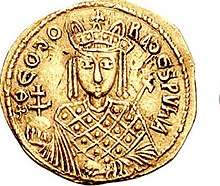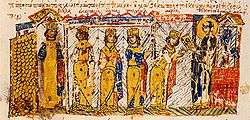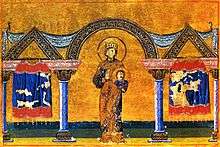Theodora (wife of Theophilos)
Theodora (Greek: Θεοδώρα, Medieval Greek: [θeo'ðora] c. 815 – after 867) was a Byzantine empress as the spouse of the Byzantine emperor Theophilos, and regent of her son, Michael III, from Theophilos' death in 842 to 855. For her restoration of the veneration of icons, which ended the Byzantine Iconoclasm, she is venerated as a saint in the Eastern Orthodox Church; her Feast Day is 11 February. Several churches hold her as their patron saint.
Theodora | |
|---|---|
 Theodora on a contemporary coin | |
| Venerated in | Eastern Orthodox Church |
| Feast | 11 February |
Family
Originally from Paphlagonia, Theodora was of Armenian aristocratic descent.[1] The names of her parents were preserved in Theophanes Continuatus, the continuation of the chronicle started by Theophanes the Confessor. They were Marinos, a drungarios, and Theoktiste Phlorina. Some modern genealogists, including Cyril Toumanoff and Nicholas Adontz, have suggested a link of Theodora's family with the Armenian noble clan of the Mamikonian. According to Nina Garsoïan in the Oxford Dictionary of Byzantium, however, "[a]ttractive though it is, this thesis cannot be proven for want of sources."[2] Thus genealogists attribute Mamikonian ancestry to Marinos; he is an alleged son of Artavazd Mamikonian, who was head of the House in the 770s. Artavazd headed a large-scale Armenian rebellion against the Abbasid Caliphate that was crushed in the Battle of Bagrevand in 775, after which the family lost power, and many of its members found refuge in Byzantium. Manuel the Armenian, a leading general of Theophilos, was her uncle.
Theodora was a sister of Bardas and Petronas. Theophanes also records three sisters: Kalomaria, Sophia and Irene. Irene reportedly married Sergios, brother of Patriarch Photios I of Constantinople.
Marriage
In 829, Theophilos succeeded to the throne. He was sixteen years old and unmarried. The following year his stepmother, Euphrosyne, proclaimed a bride-show. Potential brides from every theme travelled from their homelands to Constantinople, Theodora among them. The poet Kassia was said to have taken part. The bride-show took place in May 830, and Theodora was chosen to become empress, probably by Euphrosyne. The marriage took place on 5 June 830, in Hagia Sophia. Empress Euphrosyne soon retired to a convent and Theodora remained the only augusta.

The family of Theodora seems to have followed her to court. Her brothers became officials and her sisters married into the court aristocracy. During her own marriage she bore Theophilus five daughters and two sons:
- Constantine, co-emperor from c. 833 to c. 835
- Thekla (c. 831 – after 867), who appeared on coinage as Augusta during Theodora's regency and was later exiled to a monastery by Michael III
- Anna (born c. 832), who was exiled to the monastery of Gastria
- Anastasia (born c. 833), who was exiled to the monastery of Gastria
- Pulcheria (born c. 836), who was exiled to the monastery of Gastria
- Maria (c. 838 - c. 842), who was betrothed to Caesar Alexios Mosele
- Michael III (19 January 840 – 23 September/24 September 867), who succeeded as emperor
Despite the fact that Theophilus was an iconoclast, Theodora held fast to the veneration of icons which she kept in her chambers in the imperial palace. One story holds that a servant witnessed her venerating her icons and reported her to the emperor. When her husband confronted her about the incident she stated that she had merely been "playing with dolls."[3] Two of her icons are kept at the monastery of Vatopedi on Mount Athos to this day and are referred to as "Theodora's Dolls". They are displayed annually on the Sunday of Orthodoxy.
Theodora is said to have intervened to save Lazarus Zographos from further torture under her husband. Whether their opposing religious beliefs strained their relationship is unclear. Theophilus' health however eventually failed and he died on 20 January 842. He was about twenty-nine years old.
Regency

Following the death of her husband, Theodora served as regent for her son Michael. She overrode Theophilus' ecclesiastical policy and summoned a council under the patriarch Methodius, in which the veneration, but not worship, of icons (images of Jesus Christ and the saints) was finally restored and the iconoclastic clergy deposed. She carried on the government with a firm and judicious hand; she replenished the treasury and deterred the Bulgarians from an attempt at invasion.[4] However, it was during her regency that a vigorous persecution of the Paulician heresy commenced.
In order to perpetuate her power she purposely neglected her son's education, and therefore must be held responsible for the voluptuous character which he developed under the influence of his uncle Bardas,[4] who was Theodora's brother and likewise of Mamikonian heritage.[5] Theodora endeavoured in vain to combat Bardas's authority; in 855 she was displaced from her regency at his prompting, and being subsequently convicted of intrigues against him was relegated to the monastery of Gastria in 857.[6][7] Both Bardas and Michael would eventually be assassinated by Basil I, who would then usurp the throne and establish the Macedonian Dynasty. Theodora would die sometime after her son's murder in 867. It is probable that Ecumenical Patriarch of Constantinople Stephen I and emperor Leo VI the Wise who is ancestor to the all latter emperors of Macedonian Dynasty are Theodora grandsons. She was canonized in recompense for her zeal on behalf of the restoration of icons as objects of veneration.[4] Her feast day is 11 February.
Relics
The incorrupt relics of St. Theodora the Empress are kept in the Cathedral of the Most Holy Theotokos Speliotissis in Corfu, Greece. The relics are carried in procession on the Sunday of the Triumph of Orthodoxy, the first Sunday of Great Lent.
Notes
- ODB, p. 255.
- ODB, p. 1279.
- Arne Effenberger, "Images of Personal Devotion: Mosaic and Steatite Icons", in Byzantium: Faith and Power (1261-1557), ed. Helen C. Evans (New York: Metropolitan Museum of Art, 2004), 210.
- Chisholm 1911.
- Christian Settipani, Nos Ancêtres de l'Antiquité
- "St. Theodora the Empress icon".
- "The Coinages of the World: Ancient and Modern". 1876.
References

- Effenberger, Arne. "Images of Personal Devotion: Mosaic and Steatite Icons." In Byzantium: Faith and Power (1261-1557), edited by Helen C. Evans, 209-214. New York: Metropolitan Museum of Art, 2004.
- Garland, Lynda (1999). Byzantine Empresses: Women and Power in Byzantium, AD 527–1204. London and New York: Routledge. ISBN 978-0-415-14688-3.CS1 maint: ref=harv (link)
- Herrin, Judith (2001). Women in Purple:Rulers of Medieval Byzantium. London: Phoenix Press. ISBN 1-84212-529-X.
- Kazhdan, Alexander, ed. (1991). The Oxford Dictionary of Byzantium. Oxford and New York: Oxford University Press. ISBN 0-19-504652-8.
External links
![]()
- Cawley, Charles, BYZANTIUM: Theodora died 867, Medieval Lands database, Foundation for Medieval Genealogy,
- A genealogy of her father
- A pedigree of her
| Royal titles | ||
|---|---|---|
| Preceded by Euphrosyne |
Byzantine Empress consort 830–842 |
Succeeded by Eudokia Dekapolitissa |